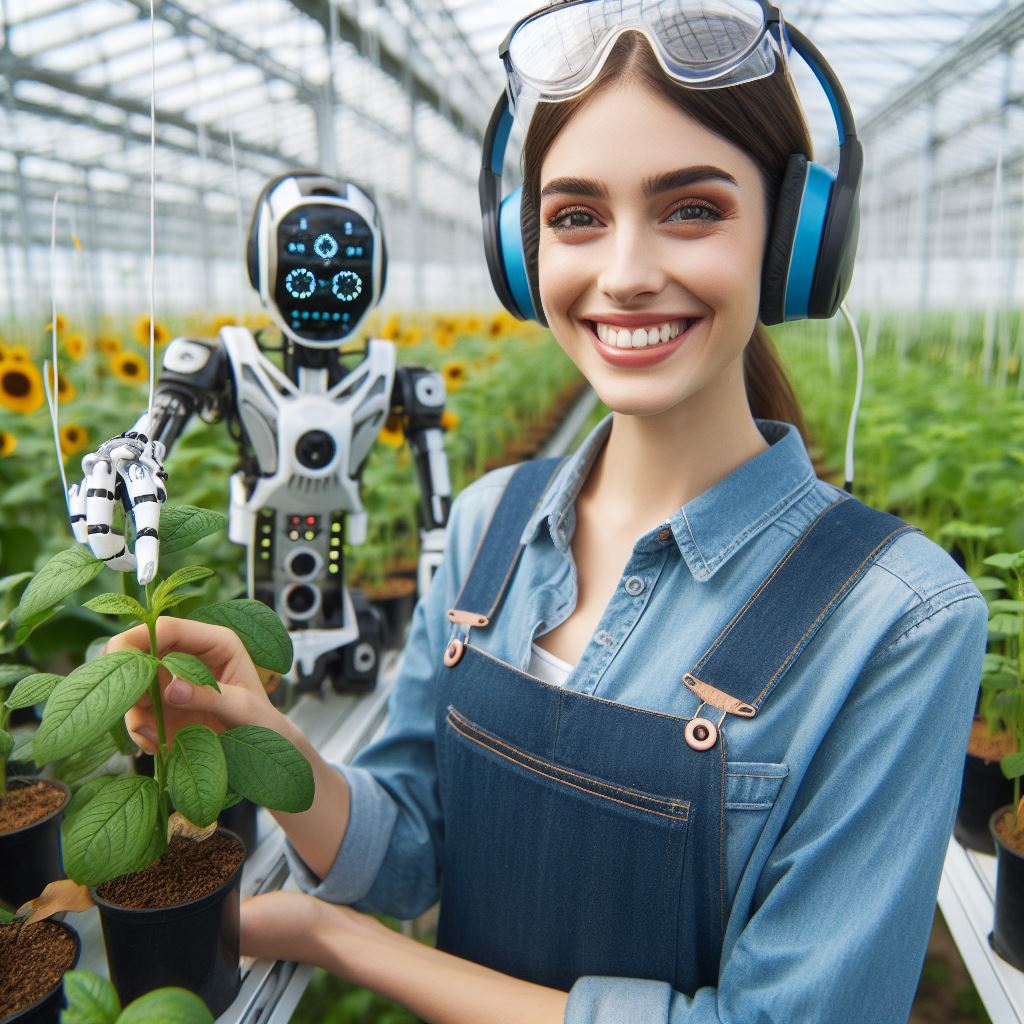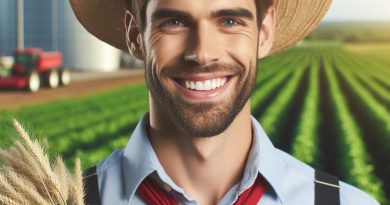Greenhouse Automation: Agri-Tech Evolution
Last Updated on January 30, 2024
Introduction
Greenhouse automation refers to the use of technology and advanced systems to control and monitor the environment inside a greenhouse.
It plays a crucial role in improving the efficiency and productivity of greenhouse farming.
The evolution of agricultural technology, known as agri-tech, has significantly contributed to the development of greenhouse farming.
Agri-tech advancements have revolutionized traditional farming practices, making them more sustainable and profitable.
By automating various aspects of greenhouse farming, such as temperature, humidity, irrigation, and lighting, farmers can create an optimal and stable environment for plant growth.
This automation helps in maximizing crop yields and reducing the risk of diseases and pests.
One of the key advantages of agri-tech evolution in greenhouse farming is its ability to mitigate labor challenges.
With automation, tasks that were previously time-consuming and labor-intensive can now be efficiently managed by machines and software.
Furthermore, greenhouse automation enables precise control over environmental factors, allowing farmers to grow crops that are not native to their geographical region.
This opens up opportunities for diversification and the cultivation of high-value crops.
Additionally, agri-tech evolution in greenhouse farming leads to more efficient resource utilization.
By monitoring and optimizing water and fertilizer usage, farmers can minimize waste and reduce environmental impacts.
In short, greenhouse automation, driven by agri-tech evolution, offers immense benefits to the agricultural industry.
It not only enhances productivity and profitability but also promotes sustainable and environmentally friendly farming practices.
As technology continues to advance, the future of greenhouse farming looks promising.
Benefits of Greenhouse Automation
Greenhouse automation brings diverse benefits to farming, enhancing productivity, and sustainability:
- Streamlining tasks: Automation optimizes irrigation, fertilization, and pest control, ensuring optimal crop growth and higher yields.
- Consistent environmental conditions: Automation maintains uniform temperature, humidity, and light levels, improving crop quality and predictability.
- Reduction in manual labor: Automated systems handle routine operations, reducing reliance on manual labor and enhancing operational efficiency.
- Precise environmental control: Automation allows precise control over factors like temperature and irrigation, minimizing resource wastage and promoting sustainability.
- Data-driven decisions: Automation facilitates extensive data collection for analysis, optimizing crop management strategies, and improving efficiency.
- Integration with smart technologies: Greenhouse automation can integrate with IoT devices and artificial intelligence, opening new possibilities for productivity enhancement.
In general, greenhouse automation offers a range of benefits for the agricultural industry.
From increased productivity and yield to improved crop quality and reduced labor costs, automation positively impacts every aspect of greenhouse operations.
With enhanced environmental control and resource management, farmers can optimize resource usage, promote sustainability, and achieve better overall efficiency.
Embracing greenhouse automation is a crucial step towards the future of agriculture, where technology and innovation play a central role in meeting the world’s food demands.
Read: Global Market Trends for Farmers
Key Technologies in Greenhouse Automation
The evolution of agriculture has seen the emergence of various technologies that have revolutionized the way we grow crops.
One such technological advancement is greenhouse automation.
Greenhouse automation involves the use of advanced systems and technologies to optimize the growth and production of crops in controlled environments.
Let’s take a closer look at some key technologies in greenhouse automation.
Climate Control Systems
One of the most important aspects of greenhouse automation is climate control.
Climate control systems consist of various components such as temperature sensors, ventilation systems, and heating systems.
These systems work together to maintain optimal temperature and humidity levels inside the greenhouse.
They ensure that crops are protected from extreme weather conditions and can thrive in a controlled environment.
Irrigation and Fertigation Systems
Efficient water management is essential for crop growth and yield.
Automated irrigation systems in greenhouses provide water to the plants based on their specific requirements.
Fertigation systems, on the other hand, combine irrigation with the application of fertilizers.
These systems automate the process of supplying water and nutrients to the crops, ensuring efficient water usage and better nutrient absorption.
Monitoring and Control Sensors
Monitoring and control sensors play a crucial role in greenhouse automation.
These sensors continuously monitor various parameters such as temperature, humidity, light intensity, and soil moisture.
They provide real-time data that helps growers make informed decisions.
In addition, these sensors can trigger automated actions such as adjusting environmental conditions or activating irrigation systems based on the predefined thresholds.
Automated Lighting Systems
Light is an essential factor for plant growth, especially in greenhouses where natural sunlight may be limited.
Automated lighting systems help overcome this limitation by providing supplemental lighting when needed.
These systems use sensors to detect the amount of natural light available and supplement it with artificial lighting to ensure optimal photosynthesis and growth.
Robotics and Machinery
The use of robotics and machinery in greenhouse automation has revolutionized the way tasks are carried out.
Robots are employed for various purposes, such as seed planting, crop harvesting, and even pruning.
They can perform repetitive tasks with precision and speed, thereby reducing labor costs and improving efficiency.
Data Management and Analysis Software
Data management and analysis software play a crucial role in greenhouse automation.
These software systems collect, store, and analyze the data obtained from various sensors and automation components.
They provide growers with valuable insights into crop performance, resource utilization, and environmental conditions.
This data-driven approach helps optimize crop production, reduce waste, and minimize the use of inputs.
In a nutshell, greenhouse automation has revolutionized modern agriculture by integrating advanced technologies into crop production.
Climate control systems, irrigation and fertigation systems, monitoring and control sensors, automated lighting systems, robotics and machinery, and data management and analysis software are key technologies driving the evolution of greenhouse automation.
By harnessing the power of these technologies, growers can achieve higher crop yields, reduce environmental impact, and ensure a more sustainable and efficient future for agriculture.
Read: Agri-Tech: Revolutionizing Farming
Implementing Greenhouse Automation
Greenhouse automation has revolutionized the way agriculture is practiced today.
With the integration of advanced technologies, farmers are able to optimize the productivity and efficiency of their operations, resulting in higher yields and lower costs.
However, implementing greenhouse automation requires careful consideration of several factors and overcoming potential challenges.
In this blog section, we will discuss the initial investment and cost considerations, the integration of automation technologies, training and support for farm operators, potential challenges and solutions, and case studies of successful automation implementations.
Initial investment and cost considerations
- Greenhouse automation involves a significant initial investment, including the cost of equipment, software, and infrastructure.
- However, the long-term benefits such as increased productivity and reduced labor costs often outweigh the initial expenses.
- It is essential to conduct a cost-benefit analysis to determine the potential return on investment and ensure its viability for the farm.
Integration of automation technologies
- The integration of automation technologies in a greenhouse involves the use of sensors, controllers, and actuators.
- Sensors monitor various environmental parameters such as temperature, humidity, and soil moisture levels.
- Controllers interpret the sensor data and make adjustments to maintain optimal conditions.
- Actuators, such as motorized vents and irrigation systems, carry out the necessary actions based on the controller’s instructions.
- The seamless integration of these components ensures efficient and effective automation.
Training and support for farm operators
- Training farm operators to effectively use and maintain the automation system is crucial for successful implementation.
- They need to understand how to operate the control interface and interpret sensor data.
- Ongoing technical support should be available to address any issues that may arise and provide assistance as needed.
- Manufacturers or system integrators should offer comprehensive training programs and robust customer support services.
Potential challenges and solutions
- The complexity of automation systems can pose a challenge for inexperienced farm operators.
- Providing simplified user interfaces and intuitive controls can help overcome this challenge.
- Ensuring compatibility and interoperability between different automation components from various manufacturers is another potential issue.
- Choosing a standardized system or seeking professional advice can help overcome compatibility challenges.
- Power outages and system failures can disrupt automation operations. Backup power sources and regular maintenance can address these issues.
Case studies of successful automation implementations
- XYZ Farms implemented greenhouse automation, resulting in a 30% increase in crop yield.
- By utilizing automated irrigation systems and climate control, they were able to optimize water and energy usage.
- ABC Horticulture integrated automation technologies, reducing labor costs by 40% and improving product quality.
- They automated tasks such as seed planting, pest control, and harvesting, leading to increased efficiency.
In summary, implementing greenhouse automation requires careful consideration of initial investment and cost, integration of technologies, training and support for farm operators, and overcoming potential challenges.
However, the benefits of increased productivity, reduced costs, and improved product quality make it a worthwhile investment for modern farmers.
By learning from successful case studies and utilizing appropriate solutions, farmers can embrace the agri-tech evolution and harness its full potential.
Read: Sustainable Practices in Agribusiness

Future Trends in Greenhouse Automation
Greenhouse automation has come a long way in recent years, and the future looks even more promising.
Advancements in technology, coupled with the need for sustainable practices, have paved the way for exciting developments in greenhouse automation.
In this section, we will explore some of the future trends that are likely to shape the industry.
Advancements in artificial intelligence and machine learning
Artificial intelligence (AI) and machine learning are revolutionizing the way greenhouse operations are managed.
These technologies enable growers to analyze large amounts of data and make informed decisions.
AI-powered systems can monitor plant health, optimize climate control, and even predict and prevent disease outbreaks.
As AI technology continues to advance, we can expect even greater efficiency and productivity in greenhouse farming.
Integration of Internet of Things (IoT) technologies
The Internet of Things (IoT) is another game-changer in greenhouse automation.
IoT devices and sensors can be used to collect real-time data on temperature, humidity, soil moisture, and other environmental variables.
This data can then be analyzed and used to automate various aspects of greenhouse operations, such as irrigation, ventilation, and pest control.
With the growing availability and affordability of IoT technologies, their integration into greenhouse systems is set to become more widespread.
Incorporation of drones and aerial monitoring
Drones offer an innovative way to monitor greenhouse crops from above.
Equipped with high-resolution cameras and sensors, drones can capture valuable data on plant health, growth patterns, and pest infestations.
This data can be analyzed to identify areas of improvement and optimize resource allocation.
Drones also have the potential to automate tasks such as crop spraying and pollination, further reducing the need for manual labor.
Embracing sustainable and eco-friendly practices
In an era of increasing environmental awareness, greenhouse automation is moving towards sustainable and eco-friendly practices.
This includes reducing water and energy consumption, minimizing chemical use, and adopting organic growing methods.
Automation technologies can play a crucial role in achieving these goals by optimizing resource usage, ensuring precise application of inputs, and promoting overall environmental stewardship.
Potential impact on job opportunities in greenhouse farming
While automation brings numerous benefits to greenhouse farming, it also raises concerns about potential job displacement.
As tasks become automated, the need for manual labor may decrease. However, the shift towards automation also opens up new opportunities for skilled workers.
Demand for professionals in fields such as AI, robotics, data analysis, and system maintenance is expected to rise.
It is crucial for the workforce to adapt and acquire the necessary skills for the evolving job market.
In fact, the future of greenhouse automation looks promising, driven by advancements in AI, machine learning, IoT technologies, and sustainable practices.
As the industry embraces these trends, it will become more efficient, productive, and environmentally friendly.
While job opportunities may change, the overall impact of automation in greenhouse farming is likely to be positive, creating new avenues for growth and innovation.
Read: Crop Diversification Strategies
Conclusion
Greenhouse automation offers a multitude of benefits for farmers, including increased productivity and efficiency.
By automating various tasks such as irrigation and temperature control, farmers can reduce labor costs and optimize resource usage.
Additionally, automation allows for better monitoring and control of the greenhouse environment, resulting in improved crop quality and yield.
Continuous evolution in agri-tech is crucial to stay ahead in an increasingly competitive industry.
As new technologies and advancements emerge, farmers must be open to incorporating them into their operations.
Adopting automation is not only necessary for sustainable and profitable farming practices, but it also ensures the long-term viability of the agricultural sector.
By embracing automation, farmers can increase their overall productivity, reduce environmental impact, and meet the growing demand for food in a rapidly changing world.
Therefore, it is vital for farmers to embrace greenhouse automation and actively seek out innovative agri-tech solutions.
Only through continuous evolution and adaptation can farmers thrive in the dynamic and challenging agricultural landscape.
Let us encourage farmers to harness the power of automation and pave the way for a sustainable and profitable future in agriculture.


